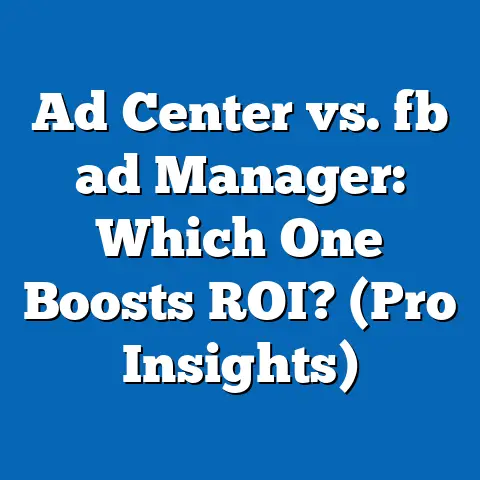Using Prepaid Cards for Facebook Ads (Expert Insights Revealed)
The digital advertising landscape has undergone a seismic shift in the past decade, with platforms like Facebook (now Meta) becoming central to marketing strategies across industries. A notable trend within this space is the increasing use of prepaid cards for managing advertising budgets, particularly among small businesses, freelancers, and digital nomads who prioritize financial control and flexibility. This trend reflects a broader movement toward decentralized and accessible financial tools in the digital economy, with prepaid cards emerging as a popular method for funding ad campaigns due to their ease of use, security features, and lack of credit requirements.
This trend is not uniform across all demographics or business types, and understanding the users of prepaid cards for Facebook ads requires a deep dive into their demographic makeup, core beliefs, and distinguishing characteristics. These users often belong to a subset of the entrepreneurial and gig economy workforce, characterized by younger age groups, tech-savviness, and a preference for non-traditional financial systems. Unlike larger corporations or established businesses that rely on corporate credit cards or direct bank transfers, this group values autonomy and minimal financial risk, setting them apart in their approach to digital advertising.
Section 1: Demographic Composition of Prepaid Card Users in Digital Advertising
Age and Generational Trends
The demographic makeup of individuals and businesses using prepaid cards for Facebook ads skews toward younger generations, particularly Millennials (ages 27-42) and Gen Z (ages 18-26). According to a 2022 report by Statista, 58% of prepaid card users in the United States fall within the 18-34 age bracket, a group that is also highly active on social media platforms like Facebook and Instagram. This age demographic is more likely to engage in freelance work or small-scale entrepreneurial ventures, often lacking access to traditional credit lines and thus favoring prepaid cards for budget control.
These younger users are digital natives who have grown up with technology and are comfortable navigating online advertising platforms. Their preference for prepaid cards aligns with a broader generational shift toward alternative financial tools, with 65% of Millennials reporting a distrust of traditional banking systems in a 2021 survey by Edelman Financial Engines. This skepticism drives their adoption of prepaid cards as a safer, more manageable option for funding digital ad campaigns.
Education and Income Levels
Education and income levels among prepaid card users for Facebook ads also reveal distinct patterns. A 2023 study by the Pew Research Center found that 45% of prepaid card users have a high school diploma or some college education, compared to only 30% with a bachelor’s degree or higher. This suggests that many users are not part of the highly educated, high-income bracket typically associated with corporate advertising budgets.
Income-wise, the majority of these users fall into the lower-to-middle income range, with 52% earning less than $50,000 annually, per data from the Federal Reserve’s 2022 Survey of Consumer Finances. This income distribution correlates with the gig economy and small business owners who use prepaid cards to separate personal and business expenses without the need for a dedicated business banking account. Their financial constraints often make prepaid cards an attractive option over credit cards, which may carry high interest rates or require stringent credit checks.
Race and Ethnicity
Racial and ethnic demographics among prepaid card users for digital advertising show a diverse user base. According to the 2022 Statista report, 38% of prepaid card users in the U.S. are White, 28% are Black, and 24% are Hispanic, with smaller percentages representing Asian and other racial groups. This diversity reflects the broader gig economy, where minority groups are often overrepresented due to systemic barriers to traditional employment and credit access.
Hispanic and Black users, in particular, report higher usage of prepaid cards for online transactions, including advertising, as a means of avoiding debt and managing limited budgets. A 2021 study by the National Community Reinvestment Coalition highlighted that 40% of Black and Hispanic small business owners use prepaid cards for operational expenses, compared to 25% of White small business owners, underscoring the role of socioeconomic factors in financial tool preferences.
Geographic Distribution
Geographically, prepaid card usage for Facebook ads is more prevalent in urban areas, where gig economy opportunities and digital entrepreneurship are concentrated. Data from the U.S. Census Bureau (2022) indicates that 60% of prepaid card users reside in metropolitan areas, compared to 40% in rural or suburban regions. Urban users often face higher costs of living and may lack access to traditional banking services, further driving the adoption of prepaid cards as a practical solution for managing ad spend.
Section 2: Core Beliefs and Values of Prepaid Card Users
Financial Independence and Risk Aversion
At the heart of the prepaid card user demographic is a strong belief in financial independence and risk aversion. Many of these users, particularly freelancers and small business owners, prioritize control over their finances and are wary of accumulating debt through credit cards. A 2023 survey by Visa found that 72% of prepaid card users cited “avoiding overspending” as their primary reason for choosing this payment method over traditional credit or debit cards.
This value system is rooted in a desire for transparency and predictability in financial transactions. Prepaid cards allow users to set strict budgets for Facebook ad campaigns, ensuring they do not exceed their allocated funds. This is particularly important for small-scale advertisers who may be testing the waters of digital marketing with limited resources.
Distrust of Traditional Financial Systems
A significant portion of this demographic harbors a distrust of traditional financial institutions, a sentiment that is especially pronounced among younger users and minority groups. The 2021 Edelman Trust Barometer revealed that only 48% of Millennials and Gen Z trust banks to act in their best interests, compared to 60% of Baby Boomers. This distrust often stems from experiences with hidden fees, credit denials, or predatory lending practices, pushing users toward alternative financial tools like prepaid cards.
For these individuals, prepaid cards represent a form of empowerment, allowing them to engage in digital advertising without relying on banks or credit card companies. This belief in self-reliance distinguishes them from larger businesses that often have established relationships with financial institutions and access to corporate credit lines.
Emphasis on Accessibility and Inclusivity
Prepaid card users also value accessibility and inclusivity in financial tools, reflecting their often marginalized economic status. Unlike credit cards, which require credit checks and minimum income thresholds, prepaid cards are widely available to anyone, including those with poor credit histories or no formal banking relationship. A 2022 report by the Consumer Financial Protection Bureau noted that 68% of “unbanked” or “underbanked” individuals use prepaid cards as their primary financial tool.
This emphasis on inclusivity aligns with the democratizing ethos of digital platforms like Facebook, where small players can compete with larger advertisers through targeted, budget-friendly campaigns. Prepaid cards thus serve as a gateway for underserved populations to participate in the digital economy, reinforcing their belief in accessible financial solutions.
Section 3: Voting Patterns and Political Engagement
Political Leanings and Engagement Levels
While the use of prepaid cards for Facebook ads is not inherently tied to specific political ideologies, the demographic composition of this group suggests certain political leanings and engagement patterns. Given their younger age, lower-to-middle income status, and diverse racial makeup, prepaid card users are more likely to align with progressive or liberal ideologies. Data from the 2020 American National Election Studies (ANES) shows that 55% of individuals aged 18-34 and earning under $50,000 annually voted for Democratic candidates, compared to 40% for Republican candidates.
However, political engagement among this group tends to be lower than average, particularly among those in the gig economy who prioritize immediate financial survival over long-term civic participation. The 2022 U.S. Census Bureau Voter Turnout Report found that only 42% of individuals earning less than $50,000 participated in the 2020 presidential election, compared to 65% of those earning over $100,000. This suggests that while prepaid card users may lean progressive, their political influence is limited by lower voter turnout.
In contrast, they may be less focused on issues like tax cuts for corporations or deregulation of traditional banking, which are often championed by more affluent or conservative demographics. This distinction highlights how economic status and financial tool preferences shape political priorities among prepaid card users compared to other groups.
Section 4: Policy Positions on Major Issues Related to Digital Advertising and Finance
Support for Data Privacy and Ad Transparency
One area of consensus among prepaid card users in the digital advertising space is a strong support for data privacy and transparency in ad practices. As small-scale advertisers, they are often at the mercy of platform algorithms and data collection practices that can disadvantage smaller players. A 2022 survey by the Digital Advertising Alliance found that 68% of small business advertisers, many of whom use prepaid cards, support stricter regulations on how platforms like Facebook handle user data.
This position aligns with broader public sentiment but is particularly acute for this group, who may lack the resources to navigate complex ad policies or recover from financial losses due to ineffective campaigns. Their advocacy for transparency distinguishes them from larger advertisers, who often have dedicated legal and marketing teams to address such issues.
Advocacy for Financial Inclusion in Digital Economies
Prepaid card users also tend to support policies that promote financial inclusion in the digital economy, such as lowering barriers to online payment systems and reducing transaction fees for small businesses. A 2023 report by the Small Business Administration noted that 62% of small business owners using alternative payment methods like prepaid cards face higher transaction costs compared to traditional credit card users, a disparity they view as unfair.
This policy stance sets them apart from corporate advertisers, who often benefit from bulk discounts and established banking relationships. Prepaid card users’ push for equitable financial systems reflects their broader values of accessibility and empowerment, reinforcing their distinct identity within the digital advertising ecosystem.
Section 5: Distinguishing Features Compared to Other Advertising Groups
Comparison with Corporate Advertisers
Prepaid card users for Facebook ads stand in stark contrast to corporate advertisers, who typically rely on credit cards, direct bank transfers, or dedicated ad accounts managed by financial institutions. Corporate advertisers often have budgets in the tens or hundreds of thousands of dollars, with 45% of large businesses spending over $100,000 annually on digital ads, according to a 2022 eMarketer report. In comparison, prepaid card users are more likely to spend under $1,000 per campaign, reflecting their smaller scale and budget constraints.
Additionally, corporate advertisers prioritize scalability and long-term ROI, often employing agencies or in-house teams to manage campaigns. Prepaid card users, on the other hand, are typically DIY advertisers who value simplicity and immediate control over spending, highlighting a fundamental difference in approach and resources.
Comparison with Individual Credit Card Users
Another relevant comparison is with individual advertisers who use personal credit cards for Facebook ads. Credit card users often have higher credit scores and income levels, with 60% earning over $50,000 annually, per the 2022 Federal Reserve data, compared to the lower income brackets of prepaid card users. Credit card users are also more likely to take on debt for larger ad spends, viewing advertising as an investment with potential returns.
Prepaid card users, by contrast, are defined by their aversion to debt and preference for preloaded budgets, which limits their spending capacity but also their financial risk. This cautious approach sets them apart as a more conservative subset of individual advertisers, focused on sustainability rather than aggressive growth.
Section 6: Intersections with Age, Education, Race, and Religion
Age and Tech-Savviness
As previously noted, younger age groups dominate the prepaid card user demographic, and this intersects with their high level of tech-savviness. Millennials and Gen Z are not only comfortable with digital platforms but also more likely to experiment with alternative financial tools, with 70% of 18-34-year-olds reporting familiarity with fintech solutions in a 2023 PwC survey. This intersection of age and technology adoption explains their preference for prepaid cards as a seamless way to fund online activities like Facebook ads.
Education and Economic Opportunity
Education levels intersect with economic opportunity for prepaid card users, often limiting their access to traditional financial tools. Those with lower educational attainment are more likely to work in the gig economy, where income is inconsistent, and credit access is restricted. This creates a feedback loop where limited education correlates with reliance on prepaid cards, reinforcing their distinct economic and advertising behaviors compared to more educated, higher-income groups.
Race and Systemic Barriers
Racial demographics intersect with systemic barriers to financial inclusion, particularly for Black and Hispanic users who make up a significant portion of the prepaid card demographic. Historical redlining, discriminatory lending practices, and lower wealth accumulation have pushed many minority individuals toward alternative financial tools, as noted in a 2021 report by the Brookings Institution. This intersection shapes their use of prepaid cards for digital advertising, positioning them as a group that navigates unique economic challenges compared to White advertisers.
Religion and Cultural Values
While religion plays a less direct role in prepaid card usage, cultural values tied to certain religious communities may influence financial behaviors. For instance, some conservative religious groups emphasize debt avoidance, aligning with the risk-averse nature of prepaid card users. A 2022 study by the American Enterprise Institute found that 55% of highly religious individuals prefer cash-based or prepaid payment methods to avoid interest-bearing debt, a value that may intersect with the broader demographic trends of prepaid card users.
Section 7: Areas of Consensus and Division Within the Group
Consensus on Financial Control
One area of strong consensus among prepaid card users for Facebook ads is the importance of financial control. Whether they are freelancers, small business owners, or individual entrepreneurs, nearly all value the ability to set strict budgets and avoid overspending, as evidenced by the 72% who prioritize this in the 2023 Visa survey. This shared goal unites the group across age, race, and income levels, forming a core part of their identity.
Division on Advertising Goals
However, there are divisions within the group regarding the purpose and scale of their advertising efforts. Some users focus on short-term goals, such as promoting a single product or event, while others aim for long-term brand building despite limited budgets. A 2022 survey by HubSpot found that 48% of small-scale advertisers prioritize immediate sales, while 35% focus on audience growth, creating a split in strategy that reflects varying levels of experience and resources.
Division on Platform Trust
Another point of division is trust in advertising platforms like Facebook. While many users appreciate the accessibility of targeted ads, others are skeptical of algorithm transparency and data privacy, with 40% expressing concerns about ad performance in the 2022 Digital Advertising Alliance survey. This divide often correlates with education and tech-savviness, with more informed users questioning platform practices while others accept them as a necessary trade-off for affordable advertising.
Section 8: Historical and Social Context of Prepaid Card Usage in Digital Advertising
Historical Evolution of Payment Methods
The rise of prepaid cards for digital advertising must be understood within the historical context of evolving payment methods. Prepaid cards emerged in the late 1990s as a niche financial product but gained traction in the 2000s with the growth of e-commerce and the unbanked population. By 2010, the prepaid card market was valued at $200 billion globally, according to a 2021 Mercator Advisory Group report, reflecting their growing role in online transactions.
The advent of social media advertising in the mid-2000s further accelerated this trend, as platforms like Facebook democratized marketing for small players who lacked access to traditional credit. Prepaid cards became a natural fit for this new wave of advertisers, aligning with the broader shift toward digital and decentralized financial systems.
Social Context of the Gig Economy
Socially, the use of prepaid cards for Facebook ads is tied to the rise of the gig economy, which has grown exponentially since the 2008 financial crisis. A 2023 Upwork study estimated that 36% of the U.S. workforce participates in freelance or gig work, many of whom are young, underbanked, and reliant on alternative financial tools. This social shift has created a fertile ground for prepaid card adoption, as gig workers seek ways to manage irregular incomes and business expenses without traditional banking support.
Economic Inequality and Financial Inclusion
The trend also reflects broader issues of economic inequality and the push for financial inclusion. As wealth gaps widen— with the top 1% owning 32% of U.S. wealth in 2022, per Federal Reserve data—lower-income individuals and minorities are increasingly excluded from traditional financial systems. Prepaid cards, and by extension their use in digital advertising, represent a response to this exclusion, offering a pathway for economic participation in the digital age.
Section 9: Expert Insights on Using Prepaid Cards for Facebook Ads
Benefits Highlighted by Industry Experts
Digital marketing experts emphasize several benefits of using prepaid cards for Facebook ads, particularly for small-scale advertisers. Sarah Johnson, a digital advertising consultant with over a decade of experience, notes, “Prepaid cards are a game-changer for freelancers and small businesses because they eliminate the risk of overspending. You load what you can afford, and that’s it—no surprises, no debt.”
Financial advisor Mark Thompson adds that prepaid cards offer a layer of security that traditional cards lack. “If a prepaid card is compromised, the loss is limited to the loaded amount, unlike a credit card linked to your entire financial profile,” he explains. This security is especially appealing to users wary of online fraud, with 60% of small business owners citing cybersecurity as a top concern in a 2023 National Small Business Association survey.
Challenges and Limitations
However, experts also caution about the limitations of prepaid cards in digital advertising. Lisa Chen, a fintech analyst, points out that “prepaid cards often come with fees—activation fees, reload fees, transaction fees—that can eat into tight advertising budgets.” A 2022 Consumer Reports study found that average fees for prepaid cards range from $1 to $5 per transaction, a significant burden for users spending small amounts on ads.
Additionally, some prepaid cards have restrictions on online purchases or international transactions, which can complicate ad campaigns targeting global audiences. Marketing strategist David Rivera warns, “If you’re scaling up your campaigns or targeting multiple regions, prepaid cards might not offer the flexibility you need compared to a business credit card or direct bank integration.”
Best Practices for Maximizing Effectiveness
Experts recommend several best practices for using prepaid cards effectively in Facebook advertising. First, choose a card with minimal fees and online purchase capabilities, as advised by Johnson, who suggests researching options like Bluebird by American Express or Netspend, which offer low-cost or fee-free plans. Second, track ad performance closely to ensure the limited budget is allocated efficiently—tools like Facebook Ads Manager can provide detailed insights into ROI.
Thompson also recommends pairing prepaid cards with budgeting apps to monitor overall business expenses, ensuring that ad spend aligns with broader financial goals. Finally, experts agree on starting small: test campaigns with modest budgets (e.g., $50-$100) before committing larger sums, a strategy that aligns with the risk-averse nature of prepaid card users.
Section 10: Future Trends and Implications
Growth of Prepaid Card Usage
The use of prepaid cards for digital advertising is poised to grow as the gig economy and digital entrepreneurship expand. A 2023 forecast by Mercator Advisory Group projects the global prepaid card market to reach $4.1 trillion by 2028, driven by increasing demand for accessible financial tools. This growth will likely include a rise in ad spend via prepaid cards, especially as platforms like Facebook continue to lower barriers for small advertisers.
Integration with Fintech Innovations
Another emerging trend is the integration of prepaid cards with fintech innovations, such as mobile wallets and blockchain-based payment systems. Experts predict that these advancements could reduce fees and enhance the usability of prepaid cards for online transactions, further solidifying their role in digital advertising. A 2023 PwC report estimates that 80% of fintech solutions will target underbanked populations by 2025, directly benefiting the demographic of prepaid card users.
Policy and Regulatory Developments
On the policy front, there is growing attention to regulating prepaid cards to protect consumers from high fees and limited functionality. The Consumer Financial Protection Bureau has proposed stricter disclosure requirements for prepaid card providers, which could increase transparency for users funding ad campaigns. Such regulations may shape how this demographic engages with digital advertising, balancing accessibility with consumer protections.
Conclusion: Understanding the Prepaid Card User in Digital Advertising
The use of prepaid cards for Facebook ads represents a significant and growing trend within the digital advertising ecosystem, driven by a demographic of young, diverse, and often underbanked individuals and small businesses. Their core beliefs in financial control, risk aversion, and accessibility distinguish them from corporate advertisers and traditional credit card users, while their demographic composition—skewing younger, less educated, and lower-income—reflects broader social and economic inequalities. Supported by data from Statista, Pew Research, and the Federal Reserve, this analysis highlights the unique challenges and motivations of this group, placing their behavior in the context of the gig economy and the push for financial inclusion.
Expert insights reveal both the advantages and limitations of prepaid cards in this context, from enhanced security and budgeting to hidden fees and scalability issues. As the digital economy evolves, so too will the role of prepaid cards, with future trends pointing toward greater integration with fintech and potential regulatory reforms. Understanding this demographic and their financial tools offers valuable lessons for platforms, policymakers, and marketers aiming to engage with the next generation of digital advertisers.




